Experimental Study on the In-Band Amplified Spontaneous Emission in the Single-Mode Continuous-Wave Yb-Doped Fiber Amplifier Operating near 980 nm
Abstract
:1. Introduction
2. Experimental Setup
3. Experimental Results
3.1. Effect of Pump Power
3.2. Effect of Seed Power
3.3. Effect of Active Fiber Length
4. Comparison with the ASE around 1030 nm
5. Conclusions
Author Contributions
Funding
Institutional Review Board Statement
Informed Consent Statement
Data Availability Statement
Conflicts of Interest
References
- Tünnermann, A.; Schreiber, T.; Limpert, J. Fiber lasers and amplifiers: An ultrafast performance evolution. Appl. Opt. 2010, 49, F71–F78. [Google Scholar] [CrossRef] [PubMed]
- Zervas, M.N.; Codemard, C.A. High Power Fiber Lasers: A Review. IEEE J. Sel. Top. Quantum Electron. 2014, 20, 219–241. [Google Scholar] [CrossRef]
- Kurkov, A.S. Oscillation spectral range of Yb-doped fiber lasers. Laser Phys. Lett. 2007, 4, 93–102. [Google Scholar] [CrossRef]
- Richardson, D.J.; Nilsson, J.; Clarkson, W.A. High power fiber lasers: Current status and future perspectives [Invited]. J. Opt. Soc. Am. B 2010, 27, B63–B92. [Google Scholar] [CrossRef]
- Shiner, B. The Impact of Fiber Laser Technology on the World Wide Material Processing Market. In Proceedings of the CLEO: Applications and Technology 2013, San Jose, CA, USA, 9–14 June 2013. [Google Scholar]
- Soh, D.B.S.; Codemard, C.; Wang, S.; Nilsson, J.; Sahu, J.; Laurell, F.; Philippov, V.; Jeong, Y.; Alegria, C.; Baek, S. A 980-nm Yb-Doped Fiber MOPA Source and Its Frequency Doubling. IEEE Photonics Technol. Lett. 2004, 16, 1032–1034. [Google Scholar] [CrossRef]
- Laroche, M.; Bartolacci, C.; Cadier, B.; Gilles, H.; Girard, S.; Lablonde, L.; Robin, T. Generation of 520 mW pulsed blue light by frequency doubling of an all-fiberized 978 nm Yb-doped fiber laser source. Opt. Lett. 2011, 36, 3909–3911. [Google Scholar] [CrossRef]
- Nilsson, J.; Minelly, J.D.; Paschotta, R.; Tropper, A.C.; Hanna, D.C. Ring-doped cladding-pumped single-mode three-level fiber laser. Opt. Lett. 1998, 23, 355–357. [Google Scholar] [CrossRef]
- Wang, R.; Liu, Y.; Cao, J.; Guo, S.; Si, L.; Chen, J. Experimental study on the all-fiberized continuous-wave ytterbium-doped laser operating near 980 nm. Appl. Opt. 2013, 52, 5920–5924. [Google Scholar] [CrossRef]
- Liu, Y.; Cao, J.; Xiao, H.; Guo, S.; Si, L.; Huang, L. Study on the output properties of fiber lasers operating near 980 nm. J. Opt. Soc. Am. B 2013, 30, 266. [Google Scholar] [CrossRef]
- Ren, Y.; Cao, J.; Du, S.; Chen, J. Numerical study on the continuous-wave Yb-doped fiber amplifiers operating near 980 nm. Optik 2018, 161, 118–128. [Google Scholar] [CrossRef]
- Boullet, J.; Zaouter, Y.; Desmarchelier, R.; Cazaux, M.; Salin, F.; Saby, J.; Bello-Doua, R.; Cormier, E. High power ytterbium-doped rod-type three-level photonic crystal fiber laser. Opt. Express 2008, 16, 17891–17902. [Google Scholar] [CrossRef] [PubMed]
- Li, W.; Matniyaz, T.; Gafsi, S.; Kalichevsky-Dong, M.T.; Hawkins, T.W.; Parsons, J.; Gu, G.; Dong, L. 151W monolithic diffraction-limited Yb-doped photonic bandgap fiber laser at similar to 978nm. Opt. Express 2019, 27, 24972–24977. [Google Scholar] [CrossRef] [PubMed]
- Aleshkina, S.S.; Bardina, T.L.; Lipatov, D.S.; Bobkov, K.K.; Bubnov, M.M.; Gur’yanov, A.N.; Likhachev, M.E. Factors reducing the efficiency of ytterbium fibre lasers and amplifiers operating near 0.98 μm. Quantum Electron. 2017, 47, 1109. [Google Scholar] [CrossRef]
- Wu, J.; Zhu, X.; Temyanko, V.; LaComb, L.; Kotov, L.; Kiersma, K.; Zong, J.; Li, M.; Chavez-Pirson, A.; Norwood, R.A.; et al. Yb3+-doped double-clad phosphate fiber for 976 nm single-frequency laser amplifiers. Opt. Mater. Express 2017, 7, 1310. [Google Scholar] [CrossRef] [Green Version]
- Valero, N.; Feral, C.; Lhermite, J.; Petit, S.; Royon, R.; Bardin, Y.-V.; Goeppner, M.; Dixneuf, C.; Guiraud, G.; Proulx, M.A.; et al. 39 W narrow spectral linewidth monolithic ytterbium-doped fiber MOPA system operating at 976 nm. Opt. Lett. 2020, 45, 1495–1498. [Google Scholar] [CrossRef]
- Soh, D.B.S.; Codemard, C.; Sahu, J.K.; Nilsson, J.; Philippov, V.; Alegria, C.; Jeong, Y. A 4.3 W 977 nm Ytterbium-doped Jacketed-Air-Clad Fiber Amplifier. In Proceedings of the Advanced Solid-State Photonics 2004, Santa Fe, NM, USA, 1–4 February 2004. [Google Scholar] [CrossRef]
- Kim, J.P.; Park, J.S.; Oh, Y.J.; Han, E.H.; Park, E.J.; Jeong, H.; Jung, Y.; Lee, K.; Lee, Y.; Cho, J. High-power extra-large-mode-area Yb-doped fiber laser and amplifier at 978 nm. J. Korean Phys. Soc. 2021, 78, 1062–1066. [Google Scholar] [CrossRef]
- Chen, M.; Cao, J.; Liu, A.; Huang, Z.; Pan, Z.; Chen, Z.; Chen, J. Demonstration of kilowatt monolithic Yb-doped fiber laser operation near 980 nm. Opt. Lett. 2021, 46, 5340. [Google Scholar] [CrossRef]
- Chen, M.; Cao, J.; Liu, A.; Huang, Z.; Pan, Z.; Chen, Z.; Chen, J. Experimental study on the 500-W-level all-fiber amplifier operating near 980 nm. Results Phys. 2021, 29, 104784. [Google Scholar] [CrossRef]
- Aleshkina, S.S.; Likhachev, M.E.; Lipatov, D.S.; Medvedkov, O.I.; Bobkov, K.K.; Bubnov, M.M.; Guryanov, A.N. 5.5 W monolitic single-mode fiber laser and amplifier operating near 976 nm. Fiber Lasers XIII: Technol. Syst. Appl. 2016, 9728, 265–272. [Google Scholar] [CrossRef]
- Yu, Y.; An, Y.; Cao, J.; Guo, S.; Xu, X. Experimental Study on All-Fiberized Continuous-Wave Yb-Doped Fiber Amplifier Operating Near 980 nm. IEEE Photonics Technol. Lett. 2015, 28, 398–401. [Google Scholar] [CrossRef]
- Aleshkina, S.S.; Lipatov, D.S.; Kochergina, T.A.; Velmiskin, V.V.; Temyanko, V.L.; Kotov, L.V.; Bardina, T.L.; Bubnov, M.M.; Guryanov, A.N.; Likhachev, M.E. All-fibre single-mode small-signal amplifier operating near 0.976 μm. Quantum Electron. 2019, 49, 919–924. [Google Scholar] [CrossRef]
- Kotov, L.; Temyanko, V.; Aleshkina, S.; Bubnov, M.; Lipatov, D.; Likhachev, M. Efficient single-mode 976 nm amplifier based on a 45 micron outer diameter Yb-doped fiber. Opt. Lett. 2020, 45, 4292. [Google Scholar] [CrossRef] [PubMed]
- Jin, C.; Shevchenko, N.A.; Li, Z.; Popov, S.; Chen, Y.; Xu, T. Nonlinear Coherent Optical Systems in the Presence of Equalization Enhanced Phase Noise. J. Lightwave Technol. 2021, 39, 4646–4653. [Google Scholar] [CrossRef]
- You, Y.; Shen, H.; Qi, Y.; He, B.; Zhou, J. Low-noise frequency and phase locking of Yb-doped fiber ring cavity via cavity modulation. J. Lightwave Technol. 2022. [Google Scholar] [CrossRef]
- Bui, T.N.; Nguyen, Q.T.; Pham, V.H. Influence of ASE Noise on the Performance of DWDM Networks Using Low-Power Pumped Raman Amplifiers. IETE J. Res. 2015, 62, 239–245. [Google Scholar] [CrossRef]
- Huang, J. Impact of ASE noise in WDM systems. Optik 2011, 122, 1376–1380. [Google Scholar] [CrossRef]
- Hiçdurmaz, B.; Temurtaş, H.; Karlık, S.E.; Yılmaz, G. A novel method degrading the combined effect of FWM and ASE noise in WDM systems containing in-line optical amplifiers. Optik 2013, 124, 4064–4071. [Google Scholar] [CrossRef]
- Tithi, F.H.; Majumder, S.P. Combined Effect of ASE Noise and SRS Induced Crosstalk on the BER Performance of a Single Span WDM System with Raman Amplifier Using Heterodyne Coherent Detection. J. Opt. Commun. 2020, 41, 347–354. [Google Scholar] [CrossRef]
- Jelger, P.; Engholm, M.; Norin, L.; Laurell, F. Degradation-resistant lasing at 980 nm in a Yb/Ce/Al-doped silica fiber. J. Opt. Soc. Am. B 2010, 27, 338–342. [Google Scholar] [CrossRef]
- Matniyaz, T.; Li, W.; Kalichevsky-Dong, M.; Hawkins, T.W.; Parsons, J.; Gu, G.; Dong, L. Highly efficient cladding-pumped single-mode three-level Yb all-solid photonic bandgap fiber lasers. Opt. Lett. 2019, 44, 807–810. [Google Scholar] [CrossRef]
- Jiang, Z.; Marciante, J.R. Impact of transverse spatial-hole burning on beam quality in large-mode-area Yb-doped fibers. J. Opt. Soc. Am. B 2008, 25, 247–254. [Google Scholar] [CrossRef]
- Leich, M.; Jäger, M.; Grimm, S.; Hoh, D.; Jetschke, S.; Becker, M.; Hartung, A.; Bartelt, H. Tapered large-core 976 nm Yb-doped fiber laser with 10 W output power. Laser Phys. Lett. 2014, 11, 045102. [Google Scholar] [CrossRef]
- Ren, Y.; Cao, J.; Ying, H.; Chen, H.; Pan, Z.; Du, S.; Chen, J. Demonstration of multi-Watt all-fiber superfluorescent source operating near 980 nm. Chin. Phys. B 2018, 27, 030703. [Google Scholar] [CrossRef]
- Ren, Y.; Cao, J.; Ying, H.; Chen, H.; Pan, Z.; Du, S.; Chen, J. Experimental study on high-power all-fiber superfluorescent source operating near 980 nm. Laser Phys. Lett. 2018, 15, 075105. [Google Scholar] [CrossRef]
- Ren, Y.; Cao, J.; Chen, H.; Ying, H.; Pan, Z.; Du, S.; Chen, J. Study on the power scalability of all-fiber superfluorescent source operating near 980 nm. Opt. Express 2018, 26, 17830–17840. [Google Scholar] [CrossRef]
- Du, H.; Cao, J.; Liu, A.; Pan, Z.; Ren, Y.; Chen, H.; Huang, Z.; Chen, J. Study on improving the efficiency of superfluorescent Yb-doped fiber source operating near 980 nm with distributed side-coupled cladding-pumped fiber. Opt. Fiber Technol. 2019, 53, 101991. [Google Scholar] [CrossRef]
- Paschotta, R.; Nilsson, J.; Barber, P.R.; Caplen, J.E.; Tropper, A.C.; Hanna, D.C. Lifetime quenching in Yb-doped fibres. Opt. Commun. 1997, 136, 375–378. [Google Scholar] [CrossRef] [Green Version]
- Melkumov, M.; Bufetov, A.I.; Kravtsov, K.S.; Shubin, A.V.; Dianov, E.M. Lasing parameters of ytterbium-doped fibres doped with P2O5 and Al2O3. Quantum Electron. 2004, 34, 843–848. [Google Scholar] [CrossRef]


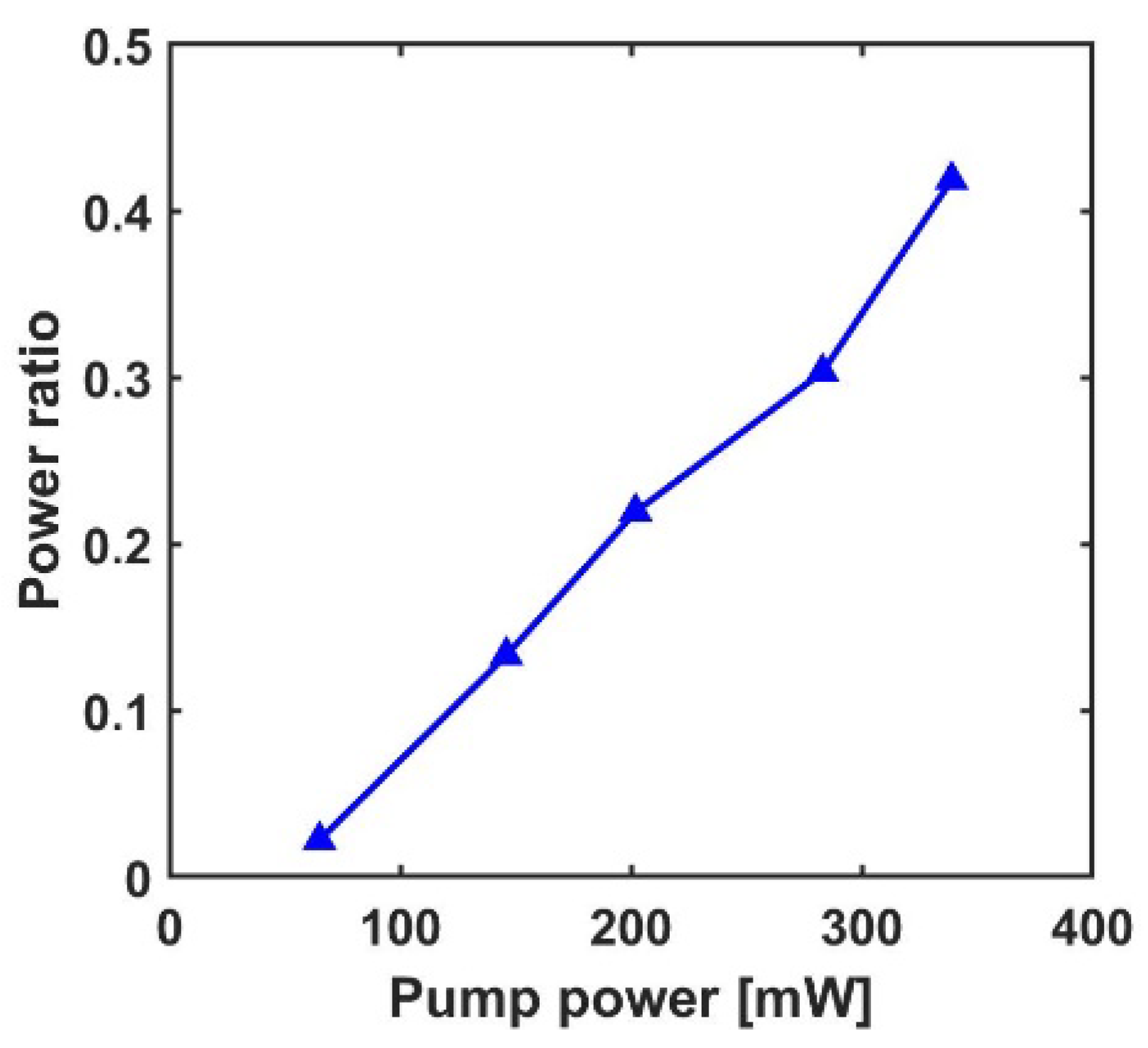
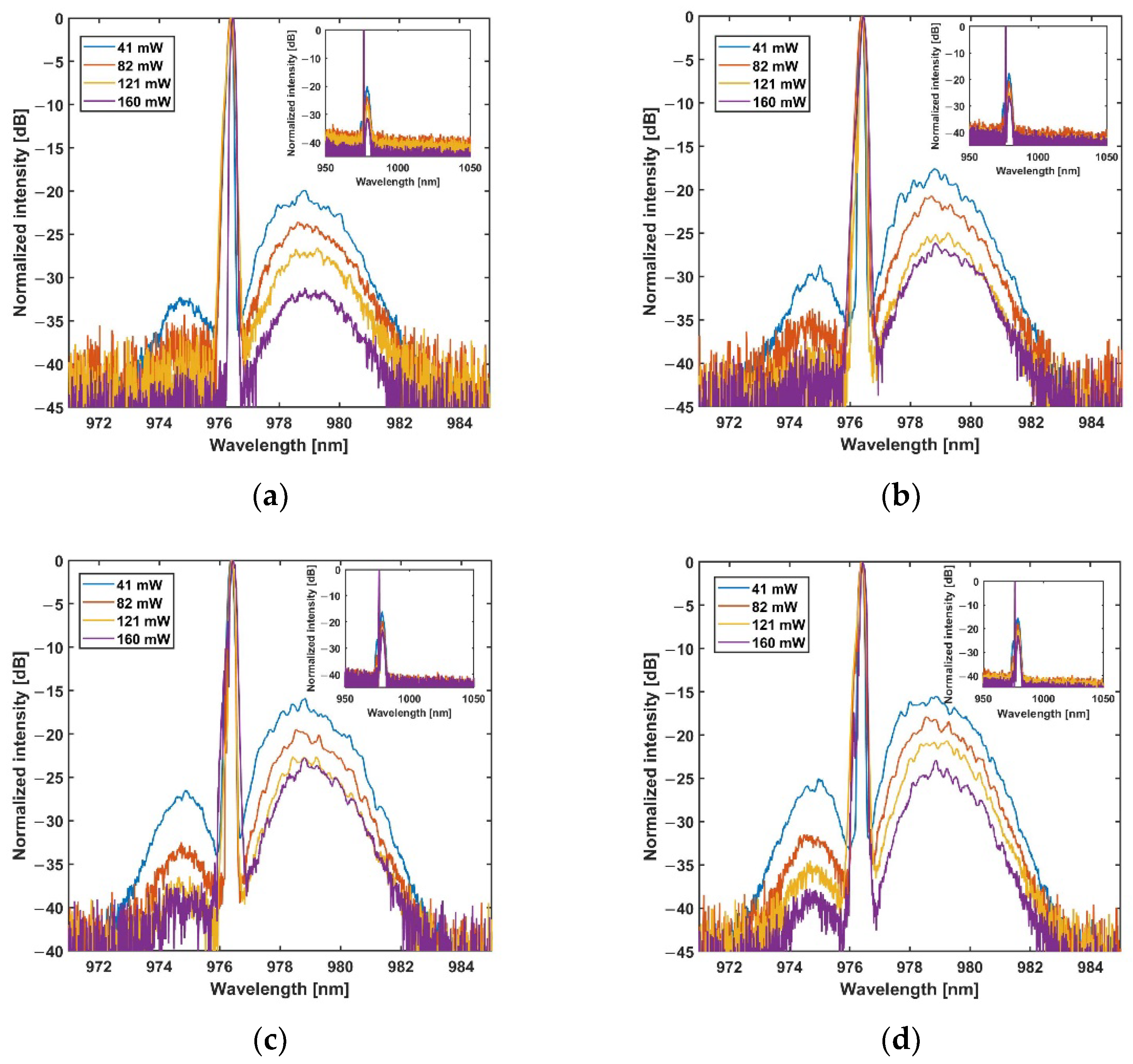

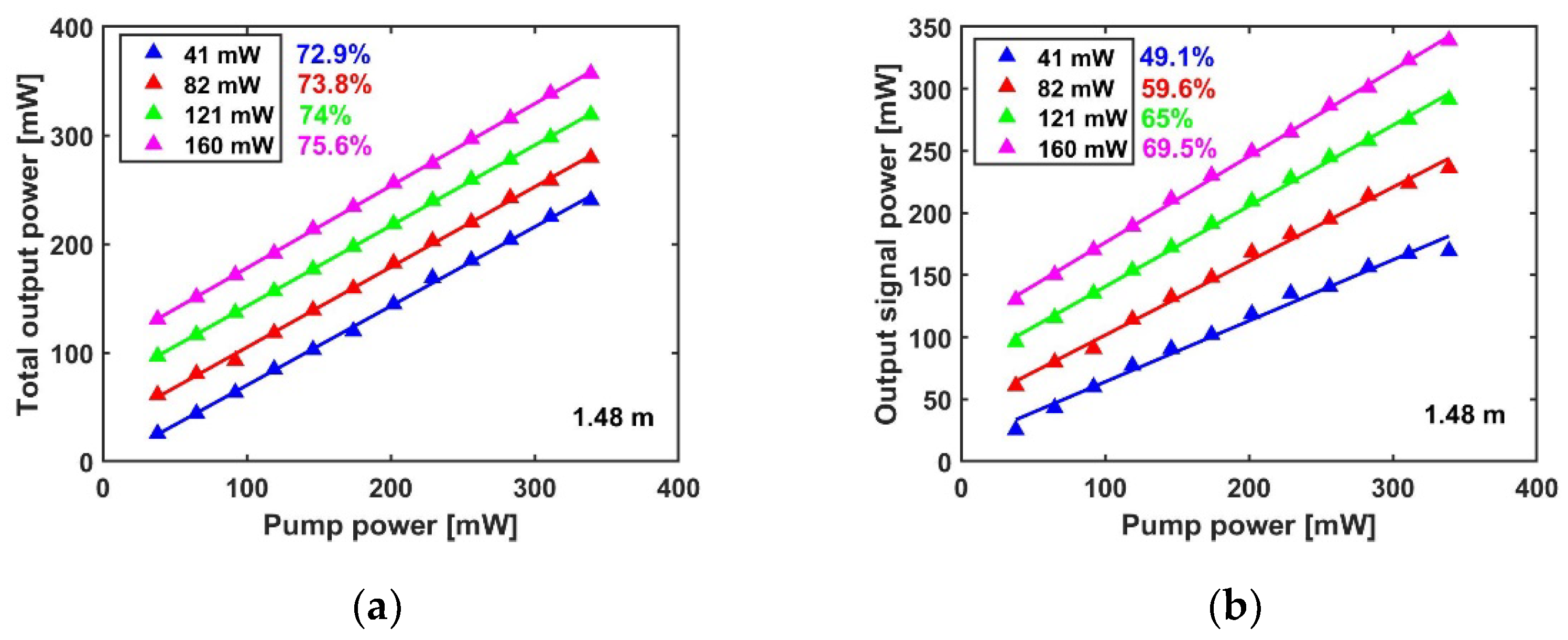
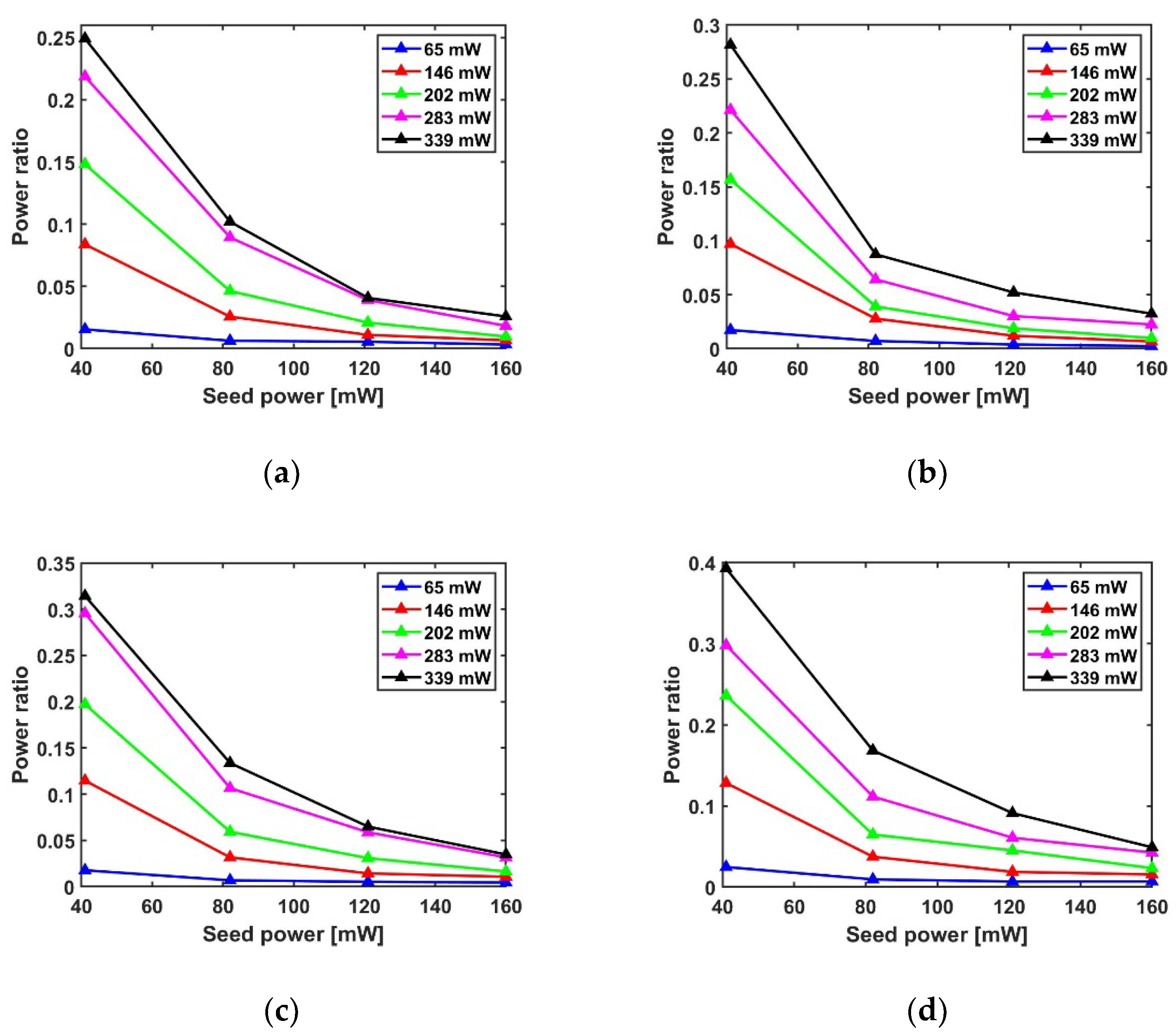
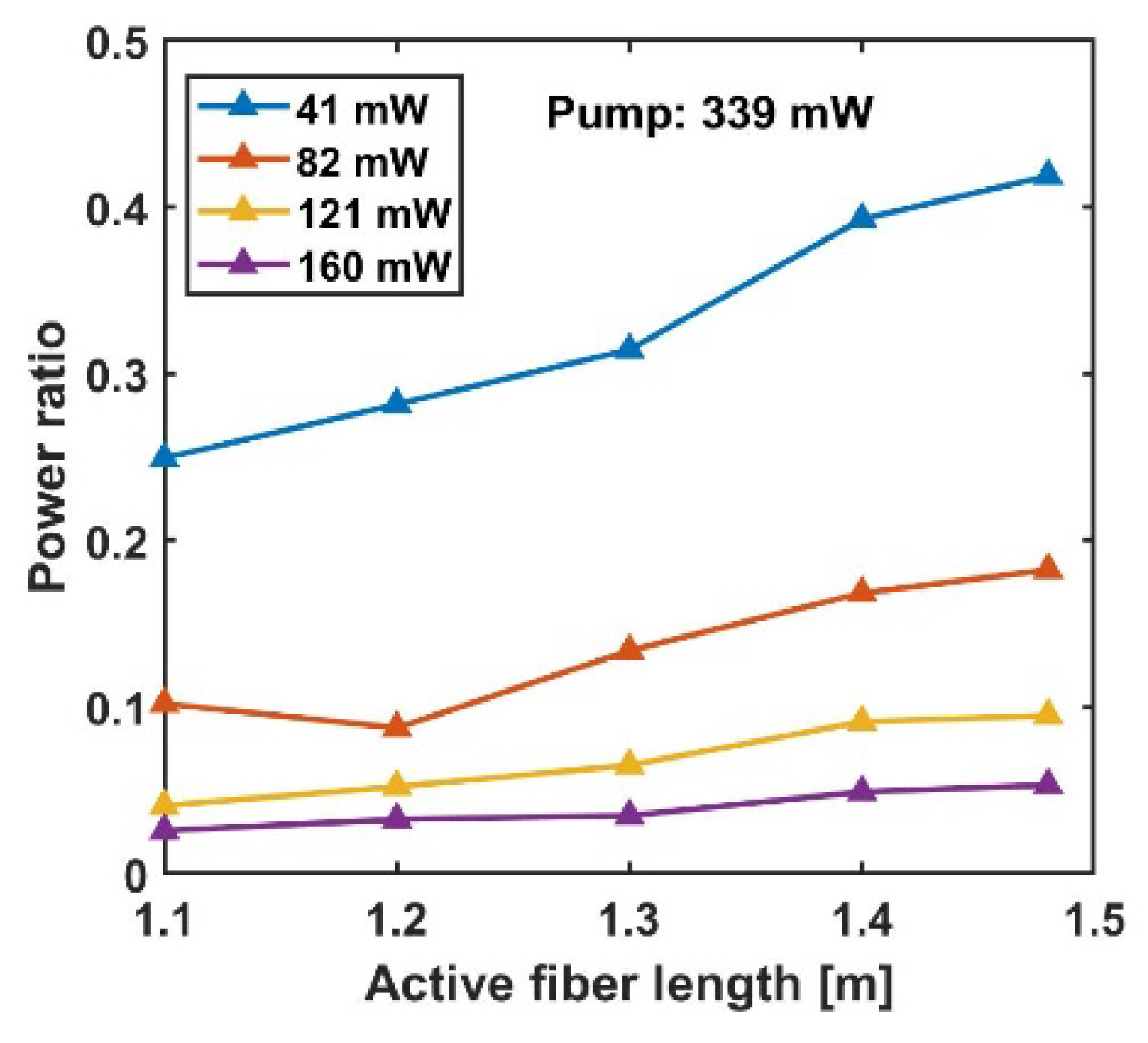
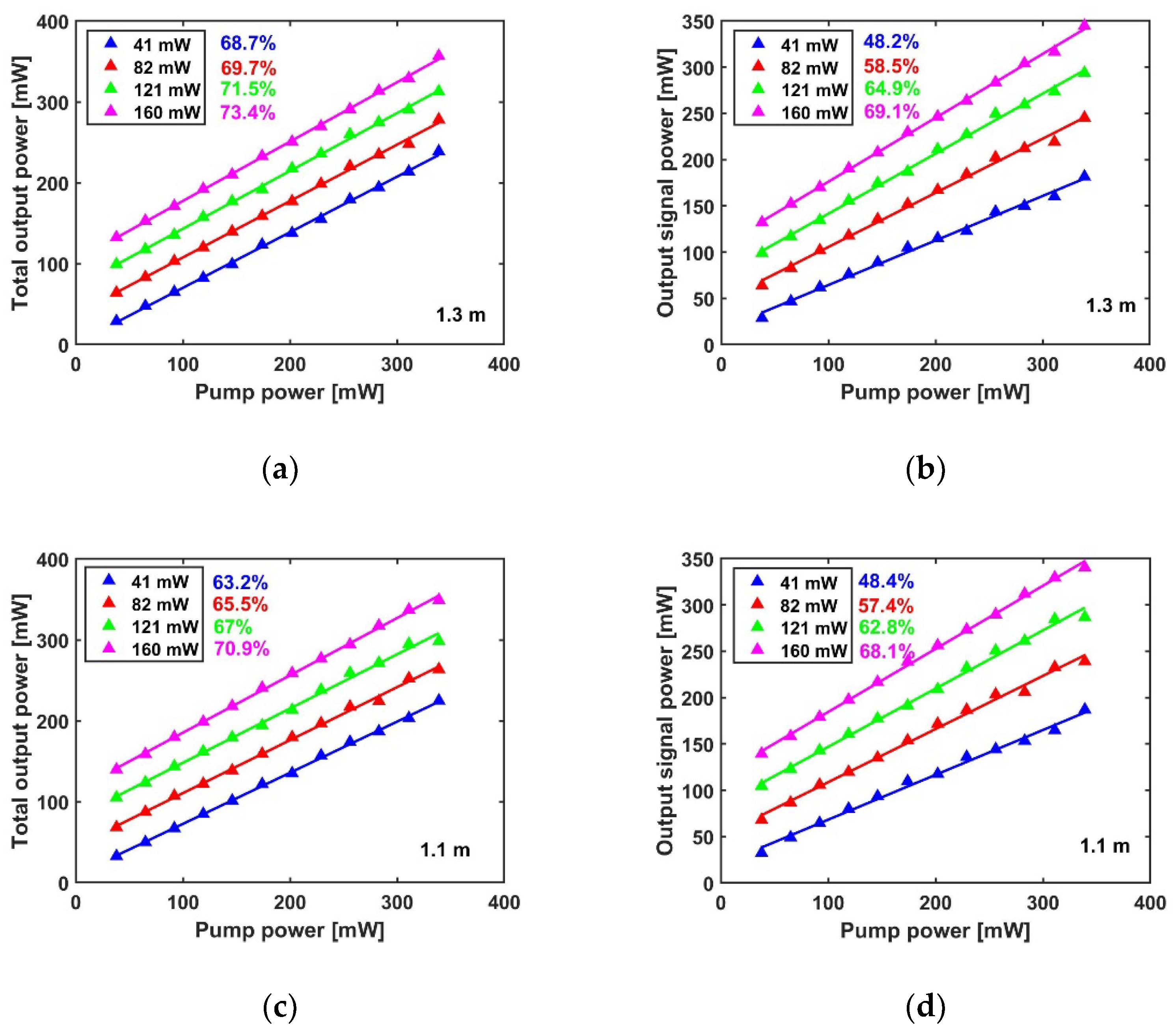
Publisher’s Note: MDPI stays neutral with regard to jurisdictional claims in published maps and institutional affiliations. |
© 2022 by the authors. Licensee MDPI, Basel, Switzerland. This article is an open access article distributed under the terms and conditions of the Creative Commons Attribution (CC BY) license (https://creativecommons.org/licenses/by/4.0/).
Share and Cite
Li, Z.; Zhou, S.; Liu, A.; Cao, J.; Huang, Z.; Chen, J. Experimental Study on the In-Band Amplified Spontaneous Emission in the Single-Mode Continuous-Wave Yb-Doped Fiber Amplifier Operating near 980 nm. Photonics 2022, 9, 377. https://doi.org/10.3390/photonics9060377
Li Z, Zhou S, Liu A, Cao J, Huang Z, Chen J. Experimental Study on the In-Band Amplified Spontaneous Emission in the Single-Mode Continuous-Wave Yb-Doped Fiber Amplifier Operating near 980 nm. Photonics. 2022; 9(6):377. https://doi.org/10.3390/photonics9060377
Chicago/Turabian StyleLi, Zhaode, Shangde Zhou, Aimin Liu, Jianqiu Cao, Zhihe Huang, and Jinbao Chen. 2022. "Experimental Study on the In-Band Amplified Spontaneous Emission in the Single-Mode Continuous-Wave Yb-Doped Fiber Amplifier Operating near 980 nm" Photonics 9, no. 6: 377. https://doi.org/10.3390/photonics9060377
APA StyleLi, Z., Zhou, S., Liu, A., Cao, J., Huang, Z., & Chen, J. (2022). Experimental Study on the In-Band Amplified Spontaneous Emission in the Single-Mode Continuous-Wave Yb-Doped Fiber Amplifier Operating near 980 nm. Photonics, 9(6), 377. https://doi.org/10.3390/photonics9060377



